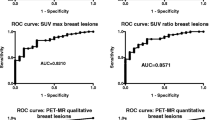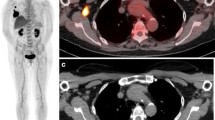Abstract
The present study compared the diagnostic accuracy of fluorine-18 2-deoxy-2-fluoro-D-glucose positron emission tomography (FDG-PET) with conventional staging techniques. The differentiation between malignant and benign lesions and the detection of multifocal disease, axillary and internal lymph node involvement, and distant metastases were evaluated. One hundred and seventeen female patients were prospectively examined using FDG-PET and conventional staging methods such as chest X-ray, ultrasonography of the breast and liver, mammography and bone scintigraphy. All patients were examined on a modern full-ring PET scanner. Histopathological analysis of resected specimens was employed as the reference method. The readers of FDG-PET were blinded to the results of the other imaging methods and to the site of the breast tumour. The sensitivity and specificity of FDG-PET in detecting malignant breast lesions were 93% and 75% respectively. FDG-PET was twofold more sensitive (sensitivity 63%, specificity 95%) in detecting multifocal lesions than the combination of mammography and ultrasonography (sensitivity 32%, specificity 93%). Sensitivity and specificity of FDG-PET in detecting axillary lymph node metastases were 79% and 92% (41% and 96% for clinical evaluation). FDG-PET correctly indicated distant metastases in seven patients. False-positive or false-negative findings were not encountered with FDG-PET. Chest X-ray was false-negative in three of five patients with lung metastases. Bone scintigraphy was false-positive in four patients. Three patients were upstaged since FDG-PET detected distant metastases missed with the standard staging procedure. It is concluded that, compared with the imaging methods currently employed for initial staging, FDG-PET is as accurate in interpreting the primary tumour and more accurate in screening for lymph node metastases and distant metastases. Due to a false-negative rate of 20% in detecting axillary lymph node metastases, FDG-PET cannot replace histological evaluation of axillary status.
Similar content being viewed by others
Author information
Authors and Affiliations
Additional information
Received 21 August and in revised form 20 November 2000
Electronic Publication
Rights and permissions
About this article
Cite this article
Schirrmeister, H., Kühn, T., Guhlmann, A. et al. Fluorine-18 2-deoxy-2-fluoro-D-glucose PET in the preoperative staging of breast cancer: comparison with the standard staging procedures. Eur J Nucl Med 28, 351–358 (2001). https://doi.org/10.1007/s002590000448
Published:
Issue Date:
DOI: https://doi.org/10.1007/s002590000448




